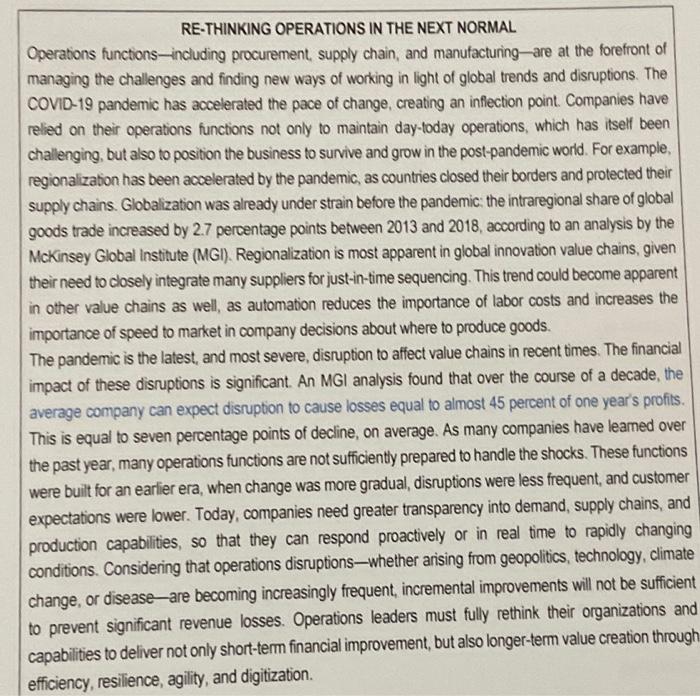RE-THINKING OPERATIONS IN THE NEXT NORMAL Operations functions-including procurement, supply chain, and manufacturing-are at the forefront of managing the challenges and finding new ways of working in light of global trends and disruptions. The COVID-19 pandernic has accelerated the pace of change, creating an inflection point. Companies have relied on their operations functions not only to maintain day-today operations, which has itself been challenging, but also to position the business to survive and grow in the post-pandemic world. For example, regionalizabion has been accelerated by the pandemic, as countries closed their borders and protected their supply chains. Globalization was already under strain before the pandemic: the intraregional share of global goods trade increased by 2.7 percentage points between 2013 and 2018 , according to an analysis by the McKinsey Global Institute (MGI). Regionalization is most apparent in global innovation value chains, given their need to closely integrate many suppliers for just-in-time sequencing. This trend could become apparent in other value chains as well, as automation reduces the importance of labor costs and increases the importance of speed to market in company decisions about where to produce goods. The pandemic is the latest, and most severe, disnuption to affect value chains in recent times. The financial impact of these disruptions is significant. An MGI analysis found that over the course of a decade, the average company can expect disnuption to cause losses equal to almost 45 percent of one year's profits. This is equal to seven percentage points of decline, on average. As many companies have leamed over the past year, many operations functions are not sufficiently prepared to handle the shocks. These functions were built for an earlier era, when change was more gradual, disnuptions were less frequent, and customer expectations were lower. Today, companies need greater transparency into demand, supply chains, and production capabilities, so that they can respond proactively or in real time to rapidly changing conditions. Considering that operations disruptions-whether arising from geopolitics, technology, climate change, or disease-are becoming increasingly frequent, incremental improvements will not be sufficien to prevent significant revenue losses. Operations leaders must fully rethink their organizations an capabilities to deliver not only short-term financial improvement, but also longer-term value creation throug efficiency, resilience, agility, and digitization. 1.1 With reference to the case study, discuss the main reasons that have been influential in transforming the operations management function. (10 marks) RE-THINKING OPERATIONS IN THE NEXT NORMAL Operations functions-including procurement, supply chain, and manufacturing-are at the forefront of managing the challenges and finding new ways of working in light of global trends and disruptions. The COVID-19 pandernic has accelerated the pace of change, creating an inflection point. Companies have relied on their operations functions not only to maintain day-today operations, which has itself been challenging, but also to position the business to survive and grow in the post-pandemic world. For example, regionalizabion has been accelerated by the pandemic, as countries closed their borders and protected their supply chains. Globalization was already under strain before the pandemic: the intraregional share of global goods trade increased by 2.7 percentage points between 2013 and 2018 , according to an analysis by the McKinsey Global Institute (MGI). Regionalization is most apparent in global innovation value chains, given their need to closely integrate many suppliers for just-in-time sequencing. This trend could become apparent in other value chains as well, as automation reduces the importance of labor costs and increases the importance of speed to market in company decisions about where to produce goods. The pandemic is the latest, and most severe, disnuption to affect value chains in recent times. The financial impact of these disruptions is significant. An MGI analysis found that over the course of a decade, the average company can expect disnuption to cause losses equal to almost 45 percent of one year's profits. This is equal to seven percentage points of decline, on average. As many companies have leamed over the past year, many operations functions are not sufficiently prepared to handle the shocks. These functions were built for an earlier era, when change was more gradual, disnuptions were less frequent, and customer expectations were lower. Today, companies need greater transparency into demand, supply chains, and production capabilities, so that they can respond proactively or in real time to rapidly changing conditions. Considering that operations disruptions-whether arising from geopolitics, technology, climate change, or disease-are becoming increasingly frequent, incremental improvements will not be sufficien to prevent significant revenue losses. Operations leaders must fully rethink their organizations an capabilities to deliver not only short-term financial improvement, but also longer-term value creation throug efficiency, resilience, agility, and digitization. 1.1 With reference to the case study, discuss the main reasons that have been influential in transforming the operations management function. (10 marks)








